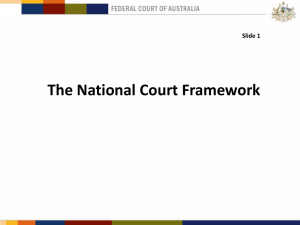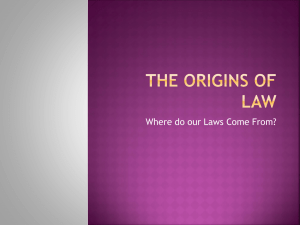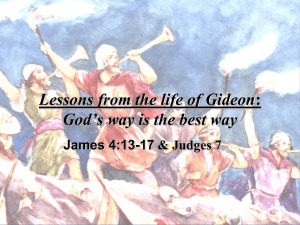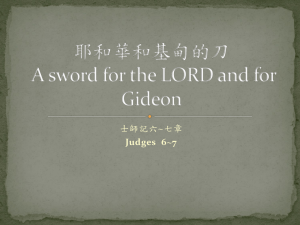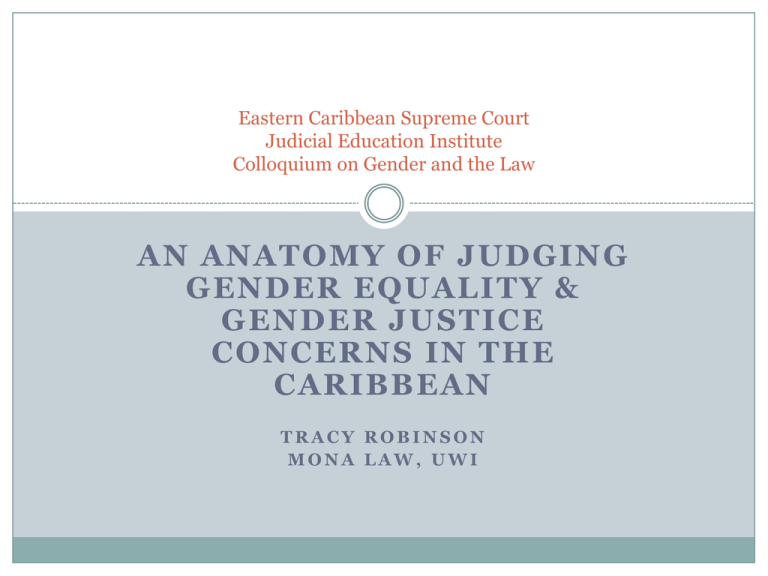
Eastern Caribbean Supreme Court
Judicial Education Institute
Colloquium on Gender and the Law
AN ANATOMY OF JUDGING
GENDER EQUALITY &
GENDER JUSTICE
CONCERNS IN THE
CARIBBEAN
TRACY ROBINSON
MONA LAW, UWI
Outline
Preliminary
points
6 Cases &
Contexts
An anatomy of judging (just
one angle)
How do judges define gender
equality issues and on what basis?
How do they understand their
role in respect of addressing
gender equality & gender justice?
When do they address gender
injustice?
What methods do they use?
Preliminary Points
IS IT LEGITIMATE FOR JUDGES TO PROMOTE
GENDER EQUALITY?
WHAT ARE THE RIGHT TERMS OR NAMES TO
DESCRIBE THE PROJECT?
PRELIMINARY POINT I: Is it
legitimate for judges to promote
gender equality
CANON 3
A JUDGE SHOULD
[A] MAINTAIN PROFESSIONAL COMPETENCE
IN THE LAW, AND SHOULD NOT BE SWAYED
BY PARTISAN INTERESTS, PUBLIC CLAMOR,
OR FEAR OF CRITICISM.
YES: Because judicial independence has an instrumental
value in the promotion of the rule of law
THE RULE OF
LAW: Judges have
an overriding duty
to apply the law
JUDICIAL
INDEPENDENCE:
Judges must have
freedom to do so
without favour/fear
Judicial independence maintains and promotes
confidence in the Rule of Law
Judges have an overriding duty to apply the law. The core of
judicial independence is the freedom of judicial officers to
perform their judicial functions on the basis of the facts in
front of them, in accordance with the law and without undue
outside interference, threats, inducements or pressure. R v
Jones (2007) 72 WIR 1, 4 [7] (SC, Bah).
Chiefly through the protection of fundamental rights and
freedoms, judges are meant to protect the citizen against
arbitrary encroachments of the state.
Byron CJ explained that “Litigation between the citizen and
the State has always been considered problematic. In
constitutional democracies under the rule of law however, the
courts have assumed jurisdiction to hear and determine all
disputes of a justiciable nature.”
Gairy v AG (1999) 59 WIR 174, 9, per Byron CJ.
The elements of the rule of law: Gender equality is not the
only demand the rule of law makes, but it is one of them
Access to justice for all
Must be able to get into the court door
Must be able to get effective relief
No one, however powerful, is above the law
But also ordinary citizens in their private as well as
public lives
Especially state actors
Overall fairness
Victims of crime are entitled to fair legal proceedings in matters that concern them
Equal protection of the law
The law cannot rule if it does not protect
All entitled to equal access to justice
PRELIMINARY POINT 2: What nomenclature to describe the project?
Gender equality/justice? Both!, Gender Neutrality? Depends!
Since judges have an
overriding duty to APPLY
the LAW, in accordance
with the CONSTITUTION,
they must be guided by
LEGAL CONCEPTS
There are constitutional
limits to how much judges
can create legal concepts.
They have an expansive
role in reshaping
restrictive interpretations
of them
International conventions
Constitutions
Disaggreg
ating
JUSTICE
• The goal
of the
rule of
law
• Overall
fairness
• The law
applies
to
everyon
e
• Everyon
e should
be
protecte
d by the
law
Develop
ing
EQUAL
ITY
• Not purely
formal
• Not a
‘mathemat
ical
formula
solved by
similar
treatment’
• Discrimin
ation only
one aspect
of equality
• Takes into
account
vulnerabili
ty
• Can mean
different
treatment
Nuanci
ng
NEUT
RALIT
Y
• access to
justice to
for all +
• responsive
ness to
inequality
and
vulnerabili
ty
The Cases and their Contexts
WHEN QUESTIONS OF GENDER EQUALITY
ARISE
The cases
Gooderidge v
AG 1998 CA
ECSC
Wade v
Roches 2004
SC, CA Bze
BIGWU v
ACCSYS
2008 IC T&T
Francois v AG
2001, HC
ECSC
Stonich v
Stonich 2003,
CA ECSC
R v Paddy
2011, HC
ECSC
Gooderidge
v AG 1998
CA ECSC
Appeal by man
convicted of
indecent assault
on stepdaughter
and sentence of
2 years
Wade v
Roches
2004 SC,
CA Bze
BIGWU v
ACCSYS
2008 IC
T&T
Unmarried
pregnant
teachers
dismissed for
breach of
contract
Junior employee
dismissed after
making
allegations of
sexual
harassment:
held to be
oppressive
Francois v
AG
2001, HC
ECSC
Challenge to the
constitutionality
of the DVA
DV amounted to
a breach of its
victims human
rights
Sentence upheld
despite
‘presumptively
prejudicial’
period of delay
b/c of special
factor
Amounted to a
violation of right
to sex equality
and to work
under
constitution
Sexual
harassment was
an industrial
relations matter
that impeded
equality
Stonich v
Stonich
2003, CA
ECSC
Ex parte orders
not in violation
of the
constitution
In exercising
broad statutory
discretion in
matrimonial
distributing
property court
must give proper
regard to the
homemaker
contribution
R v Paddy
2011, HC
ECSC
Unlawfully &
maliciously
causing gbh to
wife by hitting
her with a
hammer
Offences in a
domestic context
should be
treated no less
seriously
8 years sentence
+ $5168 in
compensation
Contexts
Workplace
Wade v Roches
BIGWU v
ACCSYS
Family
Francois v AG
Stonich v Stonich
Gooderidge v AG
R v Paddy
Family
Property Redistribution
• Application of statutory discretion
Criminal appeals
• Assessing fundamental rights of D
(and victims)
Constitutional litigation
• Assessing the constitutionality of
protective legislation
Sentencing
Workplace
Dismissal of
employee
• Interpretation of
legislation
• The development of
common law principles
Dismissal of
employee
• Application of the
constitution
How do judges define gender
equality?
DEFINITION
LEGAL BASIS
Definition of gender equality and gender justice
Respect for human
dignity
Addressing
vulnerability caused
by inequality
Equal access to
justice and equal
protection of the law
Equal consideration
and regard
Full membership
and participation in
society
Gooderidge v AG 1998 CA
Wade v Roches 2004 SC, CA
BIGWU v ACCSYS
2008 IC
• Equal regard that takes into account vulnerability
• Full membership and participation in society
• Equal consideration and regard
• Equal capacity for human flourishing, including access to economic
resources
• Equal consideration and regards
Francois v AG
2001, HC
• Violence reflects and impedes equal regard
• Private sphere is a realm of inequalities that must be publicly
scrutinised
Stonich v Stonich 2003, CA
• Private sphere is a realm of inequalities that must be publicly
scrutinised
R v Paddy 2011, HC
• Violence reflects and impedes equal regard
• Private sphere is a realm of inequalities that must be publicly
scrutinised
Primary legal basis: Constitution (the provision
does not need to say sex or women)
Preamble: WHEREAS the People of Antigua and Barbuda proclaim that they are a sovereign nation founded upon principles that acknowledge the
supremacy of God, the dignity and worth of the human person, the entitlement of all
persons to the fundamental rights and freedoms of the individual, the position of the
family in a society of free men and women and free institutions;
3.- Whereas every person in Antigua and Barbuda is entitled to the fundamental rights and
freedoms of the individual, that is to say, the right, regardless of race, place of origin,
political opinions or affiliations, colour, creed or sex, but subject to respect for the
rights and freedoms of others and for the public interest, to each and all of the
following, namely life, liberty, security of the person, the enjoyment of property and the protection of the law;
freedom of conscience, of expression (including freedom of the press) and of peaceful assembly
and association; and
protection for his family life, his personal privacy, the privacy of his home and other property
and from deprivation of property without fair compensation,
PROTECTION FROM DISCRIMINATION ON THE GROUNDS OF RACE, SEX ETC.
14.- Subject to the provisions of subsections (4), (5) and (7) of this section, no law shall make
any provision that is discriminatory either of itself or in its effect.
... no person shall be treated in a discriminatory manner by any person acting by virtue of
any law or in the performance of the functions of any public office or any public authority.
How do judges understand their
role in respect of addressing gender
equality?
As relevant to:
Delimiting wide
judicial discretion eg
property adjmt,
sentencing
Interpreting the
scope of legislation
eg industrial
relations
Having regard to
constitutional rights
even when no direct
invocation
Interpreting the
meaning of
constitutional rights
in direct challenges
The development of
the common law
consistent with
constitutional
standards
When do they address gender
inequality?
In everyday judging as a duty to develop
common law consistent with constitutional
standards
1.
Sexual harassment is a breach of the employer’s duty to
provide a safe place of work
2. As a principled way of exercising judicial
discretion
•
eg family property matters
3. Of their own initiative if justice demands it
• eg. Ensuring proper respect for victims’ rights
All Contexts including
Constitutional
Criminal
Family law
Employment
• Antidiscrimination cases
• Criminal appeals
• Challenges to constitutionality of protective legislation
• Criminal appeals
• Sentencing
• Property distribution
• Applications for protection orders
• Dismissal of employees
• Redress for sexual harassment
What methods do they use?
They see law as dynamic
Especially aware that judges ‘make’ or have made the
common law
Judges have a duty to develop it consistent with
constitutional standards
That duty is especially apparent where the common
law entrenches inequality (criminal law and family
law
Corroboration warning requirements
Unity of the spouses and marital rape
They see law as coming from multiple sources
that are hierarchical and layered
Constitutional
premise
International
norm, instrument
Specific
legislation
They see law in the context of society
They see law as a purveyor of social norms and
cultural values
They see cultural norms changing over time and the
reflection of this in domestic legislation and
international human rights law
They use these as sources, not all of equal value
They refer to social science literature and evidence
They put use both narrow and wide lens for seeing
law: closely examining the local social context and
using international and comparative law as a
‘reflective mirror’
They see law as transformative
They distinguish ‘norms’ from ‘normal’
They use ordinary language to explain notions of
human dignity and equality and why what is ‘normal’
Is changing and
Falls short of the accepted or acceptable norm as legally
defined
They see the possibility of law transforming both
material and ideological relations of gender
Disrupting gender stereotypes (Paddy, Francois)
Redistributing resources (Stonich)
Sending a message that law will rule, no impunity (George,
Paddy)
How do they
think of
themselves?
As sometimes getting it
wrong
As capable of changing
their minds and of self
reflection
As having an overriding
duty to apply the law
and in so doing
ensuring accountability
for both public and
private behaviour
Georgetown • BYRON CJ
Comm Sec • Gooderidge v
AG 1998
Judicial
Colloquium • George v S
2000
1996
• WILLIAMS JA
UN Judicial • Woodall v R
2005
Colloquium
• Mayers v R
2004
2009
Who are these judges: trial and intermediate
judges
Senior and appellate judges
But trial judges exercising judicial discretion or
interpreting legislation or the constitutions are the
standard bearers
PC rarely tackles head on equality issues as such
(Gilbert, Suratt, Ramjattan)
Questions to ask
Who has the burden of proof in bill of rights cases?
When and how should we balance different interests
and rights?
What are areas ripe for development of the common
law, including employment relations?
How should we use of international human rights
norms, instruments and jurisprudence?
How do we get appropriate evidence and arguments
before the courts, including use of amicus briefs?

